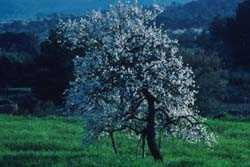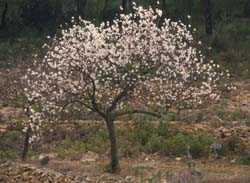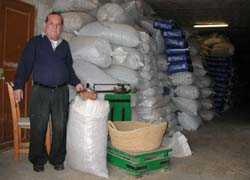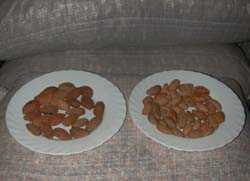|
Antonio Ramon
Torres "Toni de Can Ramunet", a good neighbour from Sant Antoni, is
a businessman who spent many years of his life as a merchant with agricultural
products.
He bought almonds,
carobs and other local crops from local peasants, mostly for export, and has
a deep knowledge of these products and the actual situation within the market.
Toni use to
buy and sell around five hundred tonnes of almonds a year and he has passed
onto me a good part of the information for these articles about the almond tree.
He has quite
a few anecdotes about almonds and also has his own belief about how this tree
reached our Islands.
Even this is
a history that he heard from his ancestors when he was a kid and doesn't remember
it with all the details, but - as nobody really knows how this happened - his
history may be as good as any other.
According to
him, the almond tree was brought to Eivissa in the very beginning of our history
by a king or a landlord of the place whose name is not remembered.
The king went
away and came back from his long trip with his young wife. Nobody knows where
she was from, but they lived happily in their big finca in Morna (near Sant
Carles, Northeast of Eivissa) until the winter came.
Then the young
wife started to lose her smile; she became dull and melancholic. "I feel
so homesick for my lovely winter snow", she said when her loving husband
asked her the reason for her sadness.
"I will
bring the snow to you and I will perfume it for you", said the king. So
he went away again and came back with thousands of young almond trees that he
planted in all the fields around the finca, from the hills to the seaside.
We can still
see plantations of this little almond tree, with plenty of flowers and tiny
almonds, not worthwhile culturing commercially, near "Es Pou des Lleó",
Sant Carles. It was not until later that they found out the fruit was a good
aliment and had a very good flavour.
Romanticism
is involved with the almond tree blossom since the very beginning of its history.
One way or the
other, the almond tree became the most planted tree of our Islands and for about
a hundred and fifty years the almonds were one of the top products for the Island's
exports, with a relatively high price.
One third of
the world's almond crop was produced in Spain and the Balearic Islands had the
largest extension of almond tree plantations of all the Spanish provinces, which
means the largest almond crop of the entire world at the time. Almonds produced
one of the most significant incomes for the local peasant and the Island's economy
until the 1970s. Then, with the arrival of the Californian almond into the world's
market, the demand for our fruit dropped drastically and obviously the price
dropped as well.
One of reasons
for the California almond's success (apart from its cheaper price) is the homogeneity
of its production - thousands of tonnes of the same kind of almonds sold without
the shell, just the selected grain, the same size and the same chemical content,
which makes its industrial processing easier and cheaper, though the almond
itself possesses inferior qualities and less oil than most of our local varieties.
In the Pitiusas Islands there is a large
variety of almonds. Some of the varieties of almond tree only function or develop
a better crop with crossed pollination, also with the pollen of the flowers
of other varieties near by. Some of them have been introduced more recently,
within the last century, but others have developed since immemorial times and
basically they only grow and are collected in our Islands.
In 1907, Dr.
Pere Estelrich i Fuster, professor of Agriculture of "l'Institut Balear"
mentioned in his book - "The almond tree and its culture in the South-east
of Spain and the Balearic Islands" - several varieties that he considers
to come exclusively from Eivissa. These are "fita mollar" or
"fita d'Eivissa" - according to him the most important and
the best of the Island's production those days - or the "Eivissenca petita,"
a little almond the size of a hazel nut, which was used as a garden tree for
its flowers, rather then its small fruits. Also "mollar grossa,"
that he considers exceptional for the big size of its grain, "mollar
de canal" presented for the first time in 1897 by the Ibicenco farmer
Antonio Marí Torres in an agricultural exhibition in Manacor (Mallorca) and
"mollar blanca", etc.
It is very difficult
to distinguish what kind of almond it is just by the tree; the differences are
in the fruit, in the almond itself, especially in the consistency of its woody
shell when it is mature.
This is how we can distinguish three groups
of sweet almonds:
Hard shell (you
need a hammer to crack them). There are about ten or twelve of this group. The
most common are "llegal fort," "fort punta,"
"forta botilera," "marcona" (one of the last
varieties to be introduced in the Island), "reginal" (very hard shell
and twin-grain) and "bernadina".
Medium-soft
shell (they can be cracked with the teeth, though it is not to be recommended)
We have "patrona," "pau" (normally twin-grain),
"fita" and "fita bord" among others.
The soft-shells
(easy to crack - sometimes with the fingers). This is the most plentiful group.
"Mollar blanca," "mollar roig," "fita,"
"mollarica" and "bec de corp," which used
to be served, together with dry figs as dessert, in old restaurants, with the
shell on because it is easy to break them open with your fingers), "princesa"
(one of the most wanted varieties for export), "infanta" (middle-size
tree and with low production, but probably the best quality almond of all) and
"mollar mcia", etc.
All together
there may be about thirty different varieties.
But the almond
is not the only profit that peasants used to get from their trees. Its very
hard brown-red wood is quite appreciated by ebonists, the leaf becomes cattle-food,
its first shell, like green velvet at the beginning, becomes leathery and black
when the almond is mature, used to be burned in braziers to warm up the house
and its ashes mixed with rain water to produce home-made lye, the woody shell
gets ground and is use as fodder for animals.
And the flowers...
The flowers are a real gift from Nature to all of us, filling our winters with
an explosion of colours and sweet aromas, romanticism and poetry. Tourists come
more and more every winter just to be a witness of this little miracle. The
almond-tree-flower, just by itself, should be enough to make the effort to save
these trees; there is no better incentive for the winter tourism.
Unfortunately,
there is a serious risk of this natural wonder disappearing in short or middle
terms. As Toni Ramunet says, the price of our first quality almond is far too
low (ten Euros per tree per year on average, the equivalent of one hour of cheap
labour), Yet it takes at least three days labour per tree, all together, plus
the use of the land, before the peasant gets this money.
It is very understandable
that the area of almond tree plantations has reduced by twenty per cent in the
last thirty years. The only way that farmers can make a bit of profit from the
tree nowadays is by pulling it up and selling it as timber for the fireplace.
There is no future for the old almond trees, not at the actual price of the
almond. (We can see nowadays how local farmers plant avocados or any other exotic
tree without flowers, which need to be watered and require more care, in what
use to be an almond field)
I'm one hundred per cent sure that if this
were happening in France, England, Germany or any other European country, the
politicians wouldn't allow this unnatural and senseless disaster to happen.
A fair price for our almonds would be enough to stop it. Let's hope that our
politicians recover their common sense and start working for our own people
and they really try harder to save this natural wonder for a better future in
Eivissa-Formentera. (In the 1980s and 1990s, the California almond selected
grain was sold in USA markets at about four dollars per kilogram; the rest of
the production was exported at half price to the rest of the world. In Spain,
thousands of tonnes of imported almonds were sold at two dollars, four hundred
pesetas at the time when our own selected grain was almost a hundred pesetas
more per kilo).
The funny thing is that there is a real market
for the Balearic almonds. They are used in many ways, in Pharmacy, as medicines
in general, especially for the skin, in "milk" as an extra aliment
for children. To produce oil, used in many industries, cosmetics, perfumes,
machinery, food, etc. As an aliment there is a no end to the list of the amount
of sweets, cakes, drinks, plus a good amount recipes in Spanish cookery done
with this fruit, eaten raw or toasted as an aperitif or with other dry fruits
as dessert.
There's also
the "Turrón" industry, a real delicacy mainly in the "Pais
Valencià" (Alicante, Jijona), invented by the Moors when they were in Spain
(from the VIII till the end of the XV centuries). It is basically ground
almonds, sugar, honey and eggs and thousands of tonnes are exported every year.
There is not a real Christmas for Spanish families anywhere in the world without
"Turrón".
Here we have
our ancestral "Salsa de Nadal" (Christmas sauce) done with
the same ingredients as turrón, boiled in water or broth, perfumed with
saffron and sometimes other spices. In terms of tradition, it is our equivalent
Christmas dessert to plum pudding, but like a thick liquid.
One of our most
appreciated desserts used to be - and still is for some - a plate of almonds,
dry figs, fresh goats' cheese and honey. Can you imagine eating this dish while
admiring an almond tree plantation in blossom? We still can do it. You are very
welcome to join us. If you do, I hope you will also join us in a prayer to save
the almond tree, with dignity, with a fair price for its production.
| 
|
 |
| Almond
Trees in Blossom
|
| 
Antonio
Ramon Torres (Toni de Can Ramunet) |

Different Sizes of Almonds |
All Pictures © Copyright Gary Hardy
|